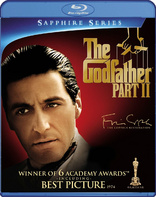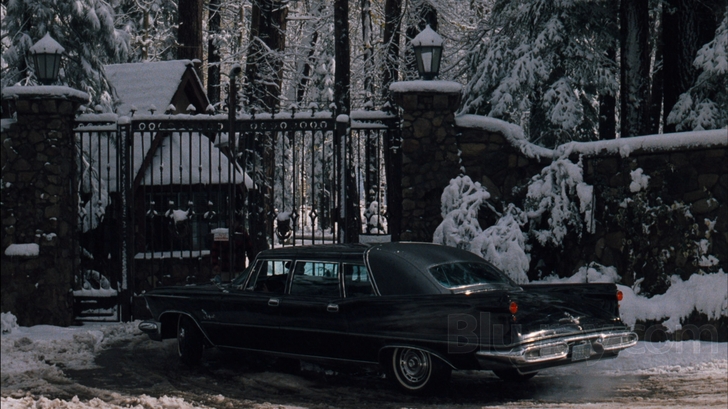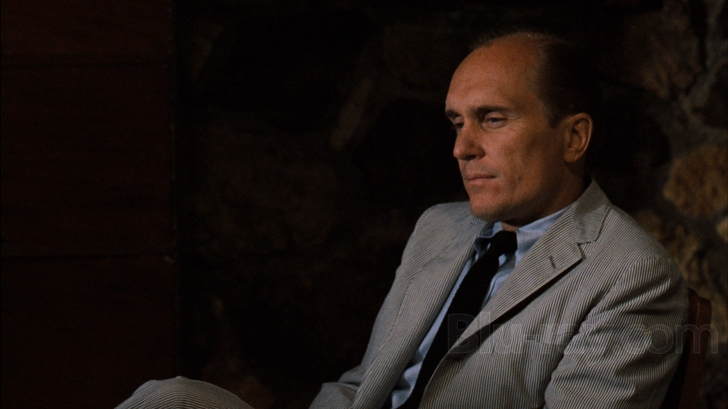The Godfather: Part II Blu-ray Movie
HomeThe Godfather: Part II Blu-ray Movie 
Sapphire SeriesParamount Pictures | 1974 | 202 min | Rated R | Feb 02, 2010

Movie rating
9.2 | / 10 |
Blu-ray rating
| Users | 4.9 | |
| Reviewer | 4.5 | |
| Overall | 4.5 |
Overview
The Godfather: Part II (1974)
Continuing saga of the Corleone family as they move to Nevada and make the casino business their major income source under the leadership of the increasingly paranoid and malevolent Michael, whose reign as the "Don" is juxtaposed against the parallel tale of his father's escape from Sicily as a young boy and his subsequent rise to power in New York's Lower East Side during the turn of the 20th century.
Starring: Al Pacino, Robert Duvall, Diane Keaton, Robert De Niro, John CazaleDirector: Francis Ford Coppola
| Drama | Uncertain |
| Epic | Uncertain |
| Crime | Uncertain |
| Period | Uncertain |
Specifications
Video
Video codec: MPEG-4 AVC
Video resolution: 1080p
Aspect ratio: 1.78:1
Original aspect ratio: 1.85:1
Audio
English: Dolby TrueHD 5.1 (48kHz, 24-bit)
English: Dolby Digital 2.0 Mono (192 kbps)
French: Dolby Digital 5.1 (640 kbps)
Spanish: Dolby Digital 5.1 (640 kbps)
Subtitles
English, English SDH, French, Portuguese, Spanish
Discs
50GB Blu-ray Disc
Single disc (1 BD)
Packaging
Slipcover in original pressing
Playback
Region free
Review
Rating summary
| Movie | 5.0 | |
| Video | 5.0 | |
| Audio | 4.5 | |
| Extras | 1.5 | |
| Overall | 4.5 |
The Godfather: Part II Blu-ray Movie Review
The greatest film sequel in history arrives without much value-added content.
Reviewed by Dustin Somner February 7, 2010The epic tale of the Corleone family reached a temporary conclusion with Francis Ford Coppola’s 1974 classic The Godfather, Part II. Nominated for eleven Academy Awards and winner of six (Best Supporting Actor for Robert De Niro, Best Art Direction, Best Director, Best Original Score, Best Picture, and Best Adapted Screenplay), the second entry in the trilogy is just as good as the first, and in many ways better. Put together, the two films are unmatched in scope and intensity, creating a new standard for modern films to strive for. Few directors put as much emotion and effort into the creation of their art, and Coppola stands among a select few who remain unwilling to compromise and fully succumb to studio pressure. The end result is often worth it (Apocalypse Now, The Conversation, The Outsiders, Youth Without Youth), but you have to wonder what toll the experience takes in the years that follow.
Following budgetary overages on THX 1138 (directed by George Lucas), Coppola’s fledgling studio American Zoetrope needed some quick capital, which led to his agreement to direct The Godfather (with Paramount). His rocky relationship with studio executives (regarding casting choices, budget, etc.) almost led him to turn the reigns over to Martin Scorsese (Mean Streets, Goodfellas, Casino), but he eventually returned to direct the sequel when he was promised a higher budget and allowed the opportunity to direct his pet project The Conversation. American Zoetrope still continues to produce films by members of the Coppola family, allowing the legendary director new opportunities to make personal films for the sake of art. Operating outside the typical Hollywood studio system is exactly what Francis Ford Coppola originally wanted to do, and he’s finally realized his dream.

"You can have my answer now."
The second film picks up where the first one left off, with Michael (Al Pacino) expanding his family’s influence and power in Nevada. Seeking to separate from the tumultuous state of affairs in New York, the Corleone family has moved to a compound in Lake Tahoe where Michael can oversee their gambling interests. One of his supporters in this new venture is a powerful man named Hyman Roth (Lee Strasberg), who’s running an operation down in Cuba and looking for Michael to return the favor by investing in his ventures down south. This relationship becomes difficult when Michael is visited by Frank Pentangeli (Michael Gazzo), who the Corleone’s left in charge of their New York affairs. Frank seeks Michael’s permission to kill the rival Rosato Brothers in in New York, but Michael refuses due to the brother’s connections with Roth (and his desire to maintain a good relationship with Roth). The decision angers Frank and leads to an assassination attempt on Michael’s life. Intent on finding out who put the lives of his family at risk, Michael sets a trap by visiting Hyman Roth in Cuba and divulging the identity of the man who ordered the hit. At the same time, he informs Frank that Roth was responsible for the attempt on his life, and bides his time while the cards fall into place.
In between this continuing storyline set during the 1950’s, we’re shown clips of Vito Corleone’s (Robert De Niro) earlier life, before the full establishment of the organized crime syndicate. Following a harrowing escape from Italy, the young Vito grows up as a poor orphaned immigrant in the bowels of New York City. He eventually finds a wife, begins a family, and settles down for a modest living as clerk at a local shop. However, he remains keenly aware of a heavy-handed enforcer named Don Fanucci (Gastone Moschin), who throws his weight around the neighborhood and demands payment from the local businessmen. When Vito loses his job due to orders given by Fanucci, Vito befriends a local thief (Bruno Kirby) and resorts to petty crime in order to feed his family. Fanucci learns of their little business venture and soon comes calling, but Vito is far more clever than anyone imagined.
The Godfather, Part II is an evolution of the style originally conceived in the first film. The payoffs are better, the double-crosses are more profound, and the sins are more severe. Michael is no longer undergoing his ascension to Don, and is portrayed right from the beginning as a man to fear. One of the greatest scenes in the film is the opening sequence when Nevada Senator Pat Geary (G.D. Spradlin) attempts to extort $250,000 from Michael for a $20,000 gaming license. The hotshot senator verbally spits on the Corleone family name, while grinning ear to ear over the perceived power he hangs over Michael’s head. After sitting calm and collect during the entire exchange, Michael tells the exiting senator he can have his response right now, and orders him to give them the license free-of-charge. He stops short of saying “or else”, but the implication is quite clear, and establishes the mood for the rest of the film. Michael is no longer an innocent bystander in the family business, he IS the family business. If you cross the Don, you should likely start counting the days until your execution and look over your shoulder around every corner.
The flashback sequences to Vito’s journey from child to man offer a glimpse into the history of a family we know intimately well by the conclusion of the 2-part film. The reason they are so effective within the structure of the plot is because they serve as a reference point for the events that follow. We’ve all seen numerous rags to riches stories over the years, but it helps to know more about Vito’s entire life, and how he achieved such a reverent status among his peers (in the first film). Looking at it from a different angle, we can associate with Michael’s actions in the present day, since we learn of the hardships his father endured to give the family a better life. Imagine sitting around as a child watching your father build an empire, and then suddenly become the recipient and guardian of that empire. As much as you might disagree with aspects of the family affairs, you have countless individuals that count on you for their livelihood. Likewise, assuming the position of Don is not something you can easily give up without taking a bullet to the head. As stated by Michael Corleone “women and children can be careless, but not men”. Every move must be calculated, and every strike precise in the chess game of organized crime.
The Godfather: Part II Blu-ray Movie, Video Quality 

Presented in 1080p utilizing the AVC codec (at an average bitrate of 26Mbps), The Godfather, Part II demonstrates the same level of excellence we witnessed with the original. Since this is the same disc found in the original four-disc collection, there's no reason to double dip, but as many of you already know, this is visual perfection at its finest. The restoration efforts by Robert Harris and the MPI group are nothing short of amazing, especially when you consider the exhaustive global search they undertook to track down negatives with the least damage. One of the highlights on the boxed set of the complete collection is an informative documentary by Francis Ford Coppola, Robert Harris (restoration expert), and Gordon Willis (cinematographer), covering the restoration process in detail. Those of you who never saw The Godfather, Part II during the days of VHS or any other point during the past 38 years should take the opportunity to witness the level of effort required to restore the film, since it will provide a greater sense of appreciation for what you're about to see.
Getting down to the particulars of the transfer, you can expect the same level of crushing blacks, yellowed tones, and heavy film grain from the first feature. This is an intended effect by Gordon Willis, who felt the film should be shot in a manner that recreates a vintage look. As a result, the film's not meant to blow your mind with well-rendered shadow detail or a naturalistic palette. However, what it does deliver is an amazing sense of style which truly becomes The Godfather epic.
The one major difference you'll notice with the artistic design of Part 2, is a further extension of the vintage style during the flashback sequences of Vito Corleone's early days. These scenes ramp up the blown out appearance and deepen the crushing blacks, making it instantly clear when a transition back to the early 1900's occurs. Detail takes a noticeable hit as a result, but it's never troublesome in the context of the film.
I know I keep tossing around the phrase "intended appearance", but that's what this visual experience really boils down to. If you hate film grain and expect every Blu-ray release to look like Transformers, this might not be a worthy addition to your collection. However, long-time fans and film historians will have zero complaints regarding the appearance of The Godfather, Part II, since it represents a profound step in the right direction for the restoration of film classics.
The Godfather: Part II Blu-ray Movie, Audio Quality 

Delivered in TrueHD 5.1, the primary audio track is nearly as impressive as the visual presentation, though Paramount's likely faced with a small number of fans preparing to cry foul over the choice to tinker with the original mono track. Fortunately, the mono offering is still provided on the disc, but I'd wager most viewers will opt for the newly remastered lossless track. As such, I've stuck with the lossless offering for this review, and found the results immensely satisfying. Beginning with the musical score by Nino Rota (who finally won an Academy Award for The Godfather, Part II after a disqualification ruined his chances on the first film), we realize a dramatic sense of immersion and depth in the rich instrumental numbers that orchestrate the changes in emotional tone throughout the film. A mono soundtrack simply can't create the same effect as a robust (surround) musical experience, so it's that singular element where we realize the greatest gain in the transition to multi-channel audio. Other elements in the mix are also enhanced, but listening to the dialogue and surround effects, I still had a sneaking suspicion they were mostly emanating from the front sound stage. This shouldn't be seen as a disservice to the overall audio experience (given the source material), but is worth mentioning to anyone who's hoping for a jaw-dropping upgrade. Aside from the improvements in the musical department, the most profound change is in the overall richness or tone of the track. Gone are the occasional moments of hiss or dropout, dialogue rarely demonstrates a muffled quality, and intricacies in the environment of each scene are afforded more weight in the well-balanced track. When it comes to a value-added audio experience, this one ranks near the top.
The Godfather: Part II Blu-ray Movie, Special Features and Extras 

This is the one area where I feel compelled to downgrade the individual "Sapphire Series" release of the first two films (the third entry in the trilogy was left out since it didn't win an Academy Award, despite receiving seven nominations). Given the wealth of supplements included on the bonus disc of the The Godfather Collection, I can't fathom how any fan could be satisfied with the mere inclusion of Coppola's audio commentary track on each disc. When I say mere, I'm not downplaying the significance of the director's in-depth discussion of the film's production, story, themes, and actors, but simply pointing out the value that's lost when you remove the excellent documentaries included in the full set.
In the end, this is the version to get if you're only concerned with owning the films themselves, and bonus materials are of little concern (or if you kept the prior DVD bonus features and are uninterested in the newly added HD content). Personally, I found the documentary on the restoration process worth the price of admission alone, so I fall in the camp that would rather own the complete collection.
The Godfather: Part II Blu-ray Movie, Overall Score and Recommendation 

If you chose not to pick up the original 4-disc collection containing The Godfather trilogy, and you despise The Godfather, Part III enough to pass on the wealth of special features included in the prior release, this is your opportunity to add a historical classic to your collection. From a personal standpoint, I'd much rather own all three films and a wealth of special features, but that's coming from a guy who doesn't dislike the third entry in the series. From a technical point of view, this is the same lovely presentation featured in the original set, which stands as the definitive example of what's possible when you clean the original elements rather than tampering with them.
Other editions
The Godfather: Part II: Other Editions

The Godfather: Part II
Sapphire Series
1974

The Godfather: Part II
1974

The Godfather: Part II
1974

The Godfather: Part II 4K
1974

The Godfather: Part II 4K
1974
Similar titles
Similar titles you might also like

The Godfather 4K
1972

The Godfather: Part III
1990

Once Upon a Time in America
Extended Director's Cut
1984

Casino 4K
1995

The Irishman
2019

GoodFellas
1990

Boardwalk Empire: The Complete Fifth Season
2014

There Will Be Blood
2007

Carlito's Way 4K
1993

The Wolf of Wall Street 4K
2013

Live by Night
2016

Gangs of New York
Remastered
2002

Road to Perdition
2002

Scarface 4K
Gold Edition
1983

Wall Street
1987

The Untouchables 4K
35th Anniversary Edition
1987

A Most Violent Year
2014

The Godfather, Coda: The Death of Michael Corleone 4K
1990

City of God
Cidade de Deus
2002

The Sopranos: The Complete Series
1999-2007